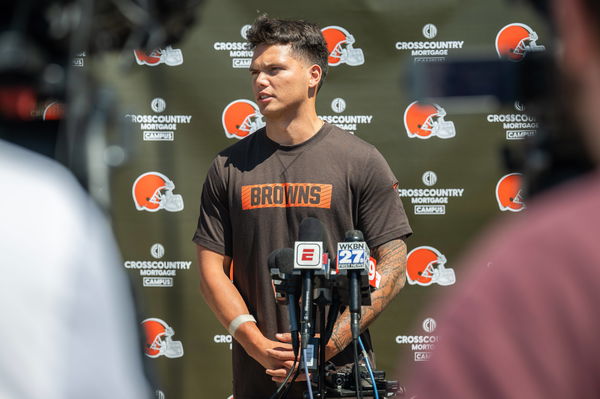
Imago
NFL, American Football Herren, USA Cleveland Browns Rookie Minicamp May 10, 2025 Berea, OH, USA Cleveland Browns quarterback Dillon Gabriel 5 talks to the media during rookie minicamp at CrossCountry Mortgage Campus. Berea CrossCountry Mortgage Campus OH USA, EDITORIAL USE ONLY PUBLICATIONxINxGERxSUIxAUTxONLY Copyright: xKenxBlazex 20250510_kab_bk4_006

Imago
NFL, American Football Herren, USA Cleveland Browns Rookie Minicamp May 10, 2025 Berea, OH, USA Cleveland Browns quarterback Dillon Gabriel 5 talks to the media during rookie minicamp at CrossCountry Mortgage Campus. Berea CrossCountry Mortgage Campus OH USA, EDITORIAL USE ONLY PUBLICATIONxINxGERxSUIxAUTxONLY Copyright: xKenxBlazex 20250510_kab_bk4_006
Before the Cleveland Browns’ played their fifth match of the season against the Minnesota Vikings in London, the head coach, Kevin Stefanski, took a very radical step; he benched an experienced player, quarterback Joe Flacco, and gave the rookie quarterback Dillon Gabriel a chance. The 1-3 made the Browns want to find out something, and Stefanski did not hesitate to do it after another home defeat.
Watch What’s Trending Now!
“It was my decision,” Stefanski said midweek. “It’s what’s best for this team moving forward.” For the rookie third-rounder out of Oregon, it was more than just a chance, like an audition for the Browns’ future.
However, on 92.3 The Fan, Browns insider Tony Rizzo, who supported the move to Dillon Gabriel, though, couldn’t help but reflect on what Flacco might’ve done with this setup. “And they did. I think if Flacco had that running game yesterday, I think play action could have actually worked and you could have stretched the field,” Rizzo said. “He’s been dealing from a point of weakness basically in every game.” Rizzo didn’t take much time to change his tune from Gabriel to Flacco after the rookie’s one loss.
ADVERTISEMENT
It’s true. Through four weeks, the Browns had only two offensive snaps with a lead, the second-worst mark in the NFL. Rizzo pointed out that Tennessee was the only team worse. “Because of that, you just haven’t had the ability to do the stuff Joe Flacco does well. And this week would have been that week,” he added.
“If Flacco had that running game yesterday, I think then play action could have actually worked and you could have stretched the field.”
Even though @SportsBoyTony supported the QB change to Dillon Gabriel, he thinks Joe Flacco would’ve given the Browns offense more life👀 pic.twitter.com/fYyGWQsOdY
— 92.3 The Fan (@923TheFan) October 6, 2025
But then came the reality check. “Now, again, who cares? Joe Flacco is not the future. You’ve got to start working on it.” Joe Flacco, in his second stint with Cleveland after guiding the team to the playoffs in 2023, has struggled this season, throwing for two touchdowns and six interceptions over four games while completing just 58.1% of his passes.
ADVERTISEMENT
Rizzo admitted that Flacco could have done better in London with a better run game and protection. The long-term play still made sense. “I didn’t kill the Browns for making the switch this week, but I think it would have been a game that Joe Flacco could have played well in because he would have had more time,” he said.
Then, he doubled down: “I’m talking about games where you have a run game and could protect the quarterback a little bit. Like, I think this would have been the week that he actually could have thrown the ball down the field and gotten those explosive plays.”
ADVERTISEMENT
While the Browns fell 21-17 after Carson Wentz’s game-winning drive in the final seconds, Dillon Gabriel proved something: he can handle the moment. He kept Cleveland alive deep into the fourth quarter. He gained five yards on two rushes and made two sacks, both of them being crashes, on the drives where Minnesota simply overpowered the line of the Browns.
His first touchdown was made on play-action in the red zone as the Vikings were scared of the run. The second? A well-timed pass to tight end David Njoku, who contentedly caught the ball to bring Cleveland a short-lived lead. Kevin Stefanski’s Verdict on Dillon Gabriel’s debut was one of a coach expecting more.
ADVERTISEMENT
Kevin Stefanski on Dillon Gabriel
“There were some good things, some rookie things to certainly clean up.” He’s right. Dillon Gabriel could’ve used his legs more and taken a few more calculated risks downfield. But for a first NFL start across the Atlantic, in a tight game, he earned his stripes. The coach didn’t take it easy on the rookie and made sure to point out his errors. At the same time, it’s his first game, and he will improve going forward.

Imago
NFL, American Football Herren, USA Cleveland Browns Rookie Minicamp May 10, 2025 Berea, OH, USA Cleveland Browns quarterback Dillon Gabriel 5 talks to the media during rookie minicamp at CrossCountry Mortgage Campus. Berea CrossCountry Mortgage Campus OH USA, EDITORIAL USE ONLY PUBLICATIONxINxGERxSUIxAUTxONLY Copyright: xKenxBlazex 20250510_kab_bk4_020
Rookie quarterback Gabriel completed 19 of 33 passes for 190 yards with two touchdowns, averaging 5.4 yards per attempt while absorbing two sacks. He posted a solid 94.3 passer rating while adding 5 rushing yards on two carries.
ADVERTISEMENT
Gabriel demonstrated poise in the pocket without forcing plays beyond his capabilities. The offensive strategy clearly emphasized safer short-to-intermediate throws that complemented the strong running game established by his fellow rookie ball carrier. All in all, though the game was lost for Dillon, it was a good outing.
And even in defeat, the Browns’ offense finally looked functional. Their 17 points tied their second-highest total of the season, and for the first time, the passing game complemented the ground attack. Rookie tight end Harold Fannin Jr. also caught one earlier, marking the first time two Browns tight ends found the end zone in the same game this season.
Rookie running back Quinshon Judkins robbed his way behind him to 110 of the 140 rushing yards of Cleveland, and the game plan of Stefanski, which emphasized running, began in that manner. Dillon Gabriel was not a deep-in-the-ball pusher, not until the last minute of the game, when he had to resort to desperation, but his presence in the pocket, his reading speed, and his faith in the playbook were evident.
Though it was a good game compared to other games they have had, it still was a loss. The head coach made it very clear after the game. “We need to do a better job closing out,” Stefanski said. “That’s an offensive thing, defense, special teams, coaches, players, you name it. We got to come away and be at our best in those moments, and we were not.”
The rookie implemented the system of Kevin Stefanski with a single clean execution and did not have any turnovers, which can be said more than Cleveland did during the first month of the season.
ADVERTISEMENT
ADVERTISEMENT
ADVERTISEMENT

